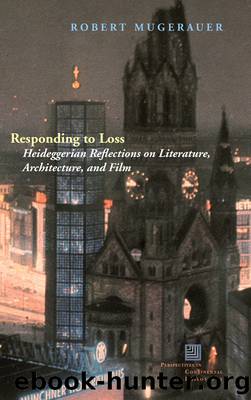Responding to Loss by Mugerauer Robert;

Author:Mugerauer, Robert;
Language: eng
Format: epub
Publisher: Fordham University Press
Figure 2.3. Old museum (left); new museum (right)
As to the inattentive mode of experience: upon arriving, signs direct one to the museum entrance, which is to the north of the new museum, through a doorway in the older yellow building. On entering the shared foyer one may not notice anything special. You do not find a traditional large lobby or other central, symmetrical area from which the exhibition spaces branch off; rather the entry space is modest, even bland, and rather busy, if not a bit cramped. To the left there is the ticket counter, then one finds the bag check, a doorway and signage to a courtyard and café, the entrance to the new museum, and tucked away to the side of that the museum shop and the exit door. Upon going into the new museum one’s ticket is taken, after which you find a flight of stairs downward to a corridor which leads to a more fully lit space. Only here have you actually arrived inside the new museum itself. Perhaps there is nothing notable here, just the experience of getting into the museum, functionally maneuvered. Or, one might note that it is a bit odd to go down a rather long stairway that is not as brightly lit as passageways normally are in public buildings.
In contrast, however, with closer attention or an understanding from the plans, a first impression is of the marked difference between the two museums. The older, traditional building in its Charlottenburg yellow is aligned with the street it fronts, whereas the radical zigzag of the Jewish Museum, with its zinc façade and fenestration that appears as random slashes, does not. If one is aware of the ideas incorporated by the architect, you realize that the only way to enter the new museum is through the old one: on the level of cultural meaning, there is the insistence that the past cannot be fully avoided—the background history and physical fabric of the city provides the only entry point. Even if the only way in is through Berlin’s history, you are at the first of a series of continuous decision points. Here you have to ask yourself: “Do I want to enter the older Berlin City Museum and see the city’s story without major emphasis on the removal of the Jews (first or at all)? Or, do I want to go this other way to engage the presence and absence brought forth by the Jewish Museum and its autonomous collection?” If at the beginning you ignore altogether or skip the exhibitions in the old museum because you are focused on seeing the new museum, you have to go down rather far—ten meters71—not so conveniently, to and through a rather steep, darkened stairway angled sideways (to the left), with muted lighting only on the edges, so that perhaps you are glad for the handrail, and then through a corridor. Is this a sort of “journey” or “quest” in which the hero descends into the underworld, to
Download
This site does not store any files on its server. We only index and link to content provided by other sites. Please contact the content providers to delete copyright contents if any and email us, we'll remove relevant links or contents immediately.
| African | Asian |
| Australian & Oceanian | Canadian |
| Caribbean & Latin American | European |
| Jewish | Middle Eastern |
| Russian | United States |
4 3 2 1: A Novel by Paul Auster(11045)
The handmaid's tale by Margaret Atwood(6850)
Giovanni's Room by James Baldwin(5876)
Big Magic: Creative Living Beyond Fear by Elizabeth Gilbert(4723)
Asking the Right Questions: A Guide to Critical Thinking by M. Neil Browne & Stuart M. Keeley(4573)
On Writing A Memoir of the Craft by Stephen King(4212)
Ego Is the Enemy by Ryan Holiday(3989)
Ken Follett - World without end by Ken Follett(3972)
The Body: A Guide for Occupants by Bill Bryson(3797)
Bluets by Maggie Nelson(3707)
Adulting by Kelly Williams Brown(3667)
Guilty Pleasures by Laurell K Hamilton(3585)
Eat That Frog! by Brian Tracy(3512)
White Noise - A Novel by Don DeLillo(3434)
The Poetry of Pablo Neruda by Pablo Neruda(3364)
Alive: The Story of the Andes Survivors by Piers Paul Read(3309)
The Bookshop by Penelope Fitzgerald(3225)
The Book of Joy by Dalai Lama(3215)
Fingerprints of the Gods by Graham Hancock(3210)
